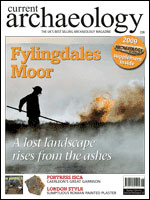This month we are featuring a Festival Special, a section devoted to the events and awards at the upcoming Archaeology Festival Cardiff 2009, 6-9 February. The Special includes a full list of award nominees and all the information you need to vote for your favourites. This is your chance, as readers, to tell us what you liked best, so please do remember to vote – the winners will be announced at the Archaeology Festival.As part of the Festival fun, we are offering delegates the opportunity to tour two major Roman sites in Wales, Caerleon and Caerwent, both of which are featured in this issue. Read their stories, then visit them for yourselves, accompanied by the authors, who will be your guides.Our dramatic cover picture shows the North Yorkshire moor fire that led to the exposure of some stunning prehistoric carved stone – a once in a lifetime chance to record this mysterious, hidden archaeology. THE LONDON STYLEPainted plaster from Roman Britain is invariably found in secondary deposits, both too fragmented and too incomplete to reassemble. But Museum of London archaeologists, digging in the basement of a former sandwich shop and pizzeria in Lime Street, London, have come across a staggering pile of painted plaster in situ at the base of the wall it once covered. The quality of craftsmanship and the intricate detail of the design have revealed a sumptuous lifestyle of the fashionable elite in 2nd century Londinium: could this have been the house of a high ranking Roman official?FYLINGDALES MOOR When fires raged across the North Yorkshire moors, concerns were primarily for the flora and fauna destroyed by the flames. But what followed was the dramatic discovery of long forgotten prehistoric archaeology, previously obscured by the dense vegetation. Neotlithic rock art, Early Bronze Age burial mounds and evidence of farming from 3,000 years ago briefly came to light. Archaeologists were able to record these amazing finds before the grasses and heathers grew back, reclaiming the land and burying these treasures once more, saved for future generations.FORTRESS ISCA Built by the soldiers of the Second Augustan Legion ‚ part of the original invasion force in AD 43 ‚ during their campaign to subdue the tribes in Wales, this great garrison at Caerleon has been the subject of archaeological interest for more than 150 years. Yet, knowledge of the fortress has remained sketchy, at best. Now, new research is revealing hitherto unknown information about the layout of the legionary fortress and uncovering new evidence for late-Roman and Medieval occupation as it was absorbed into the rural life of the local community.CAERWENTKnown as Venta Silurum, ‘the market of the Silures’, Roman Caerwent was the administrative centre for the largest civilian population in Wales. Yet it was barely mentioned in contemporary literature and little of its history had ever been recorded. Now, work on the site has brought significant new information to light not only about the origins of this once magnificent Roman capital but also about its growth, development and decline. LAST WORDThe National Museum of WalesODD SOCSThe Open Spaces Society
Current Archaeology 226
In this issue:
-Fortress Isca, Caerleon
-Fylindales Moor
-Roman Caerwent
-The London Style: painted plaster
Plus: News, Reviews, Comment, Diary, and more!
£6.95
Availability: 15 in stock
Description
Additional information
| Weight | 0.178 kg |
|---|---|
| Rest of World Delivery | £2 |
| Volume | Volume 19 |
| Published Year | 2000s |
| Cover Date | Jan-09 |
| Volume Name | Volume 19 Issue 10 |

